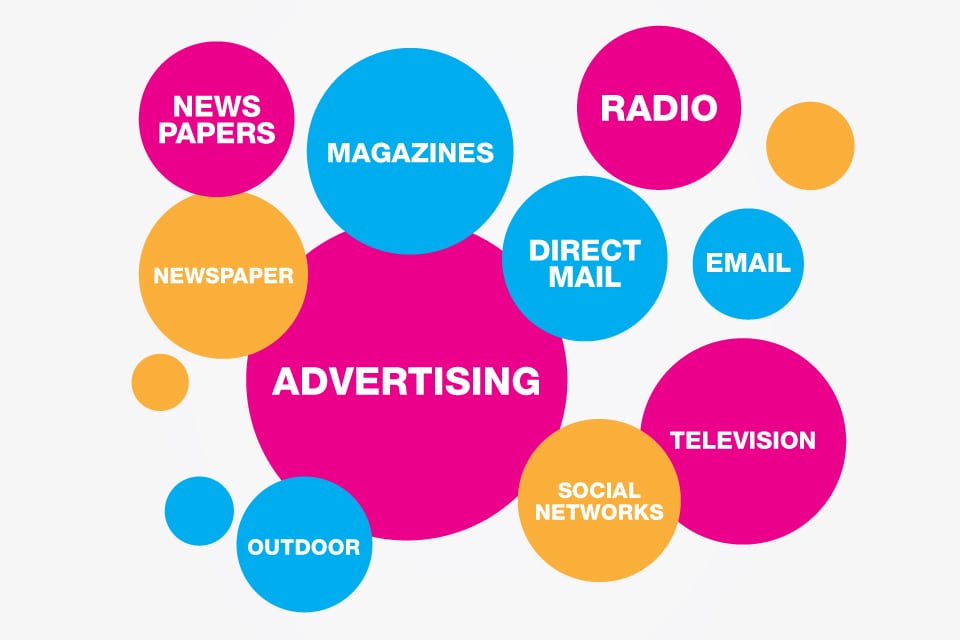Media buying, as it may be obvious from the term, is the process of buying media exposure.
Businesses, non-profits, individuals and even politicians, can all buy a share of media exposure in the form of advertising.
This media exposure can then be used to market products or to create awareness about a cause; or whatever business objective needs to be achieved.
But before going into details of what media buying is, we first need to understand that the term “media buying” is a very broad term to start with.
However, in this detailed guide to understanding the basics of media buying, we’ve tried to explain everything related to this term in the easiest way possible.
If you’re new to media buying, or had been looking for a place to understand the concept better for your business, job or academic purposes, you may be able to use this as a comprehensive guide to learn more about it.
Before moving forward, we’d like to set some expectations straight. This guide is NOT going to teach you anything about digital buying systems such as Google Adwords or Facebook ads. It is only going to focus on explaining the basics of media buying and how a typical media buying process works in an advertising, media planning, or a media agency setting.
Okay. So, let’s cut to the chase. Following is the list of topics that we’re going to cover in this series. You may jump to a more relevant topic, if you already know the fundamentals.
![]()
Comprehensive Guide:
Basics of Media Buying
- What is media buying?
- What does a media buyer do?
- What expertise is involved in media buying?
- Types of advertising and media available
- How does media buying work?
- The media buying process
- What are the benefits of media buying?
- What are the challenges of media buying?
- Media negotiation strategies
- Media buying software
![]()
1. What is media buying?
Media buying is the process of purchasing a share of media from a TV channel, a publication, a radio spot, an outdoor site or a website, for the purpose of advertising.
It is the procurement of media; a core function of an advertising process.
A media buying department’s functional role involves negotiating the best rates from media owners for an optimal placement and earning more value for an advertiser’s money.
In return, the advertisers’ enjoy more advertising mileage (higher reach or frequency), and hence better return on investment (ROI) on their marketing budgets.
You may ask, how did media buying agencies start?
Well, not long ago, all media buying was done through a media department within full-house advertising agencies.
But in 1999, WPP (one of the largest advertising conglomerates) combined the media departments of 2 of its global advertising agency networks: JWT and Ogilvy & Mather.
And the world’s first media agency was born: Mindshare, one of the biggest media agencies till date.
The reason to form Mindshare, was to combine client budgets to form a bigger clout.
This gave the newly formed company more negotiation power than competing media departments in other full-house agencies.
It was a well played strategic move by WPP that meant better offering and more money.
Later in 2003, WPP went on to purchase Tempis, and Young & Rubicam, consolidated their media departments, and formed GroupM.
GroupM is the world’s number one media investment company today in terms of its client billings.
![]()
2. What does a media buyer do?
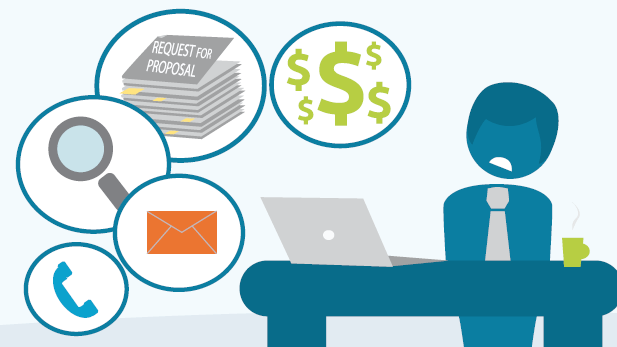
Image Credits: Integrate
So what is a media buyer’s job description and what is his or her work day like?
Media buyers negotiate the price of media, discounts, additional mileage and value for money with the media representative on behalf of an advertiser.
They even closely monitor the media vehicles themselves, monitoring agency or through an internal monitoring department to track competitive heat and ensure optimal placements.
Although media buying objectives are reflective of the overall advertising KPIs (key performance indicators), it can be safely assumed that a media buyer’s core job description is to achieve higher reach (in terms of relevant target audience) in the lowest possible budget.
Media buying roles are usually found in advertising and media agencies. Though some advertisers like to have an internal media buying resource to meet their needs.
Following are some other day to day activities that a media buyer may get involved in:
- Identifying the target audience for a particular media campaign
- Decide how best to communicate with that target audience
- Stay up to date with industry research figures, including distribution figures for print publications, viewership numbers on TV, listenership on radio, internet consumption habits and other statistics
- Monitor media buying strategy and competitor moves
- Build relationships with clients and media representatives
- Negotiate with media representatives to crack the best rates and most optimal media placements in online, broadcast, outdoor and print publications
- Communicate with media representatives to adjust media plans in response to change in the audiences’ behaviour or competitor activities
- Buy and place advertising spots in several media vehicles including pages, posters, internet banners, broadcast advertising, social ads, and outdoor placements
- Ensure efficient delivery of the media campaign to achieve desired results
- Client reporting and budget management, including the preparation of costs and deals
- Collect and Analyse consumer, media and sales data to improve the media buying strategy
- Undertake research using a wide range of specialist media resources
- Analyse the effectiveness of media campaigns and use the acquired data to improve future campaigns
- Work on a range of client accounts at the same time, often switching between various campaigns and their deadlines
- Coordinate with media planners, media manager and other departments
Before these professionals could take on the media buying role on their own, media buyers typically have to go through a rigorous negotiations skills training.
They may even assist a senior media buyer on several media campaigns for months before they could be ready to handle the big budget pressure.
![]()
3. What expertise is involved in media buying?
Media buying is a core procurement based role, and requires a knack for numbers.
Media buyers have a responsibility to efficiently spend the advertiser’s budget to achieve maximum results.
Apart from that they need good negotiation and communication skills. Team work skills are also essential, considering that media buyers have to work in close coordination with the media planners.
Sometimes, media buyers also have media planning responsibilities.
Why? It could be because of a different organizational structure.
But let’s not drift in that direction to avoid confusion.
Back to where we drifted away from.
Following is how their role may span over an entire campaign:
Collaborate. Plan. Crunch numbers. Negotiate. Crunch more numbers. Negotiate more. Crack deals.
If this sounds fun, then media buying may probably be for you.
![]()
4. Types of Advertising & Media available
With their negotiation tactics, media buyers try to get the best deal out of any required and relevant media vehicle.
The share of media they buy, is usually different in form from one media vehicle to the other.
Following are some forms of advertising available:
- Print ads in newspapers and magazines
- Video ads on TV, in cinemas and online
- Mupis and posters in side malls and stores
- Audio ads on radio
- Banners and text ads on the internet
- Billboards on outdoor sites
- Branding on mobile outdoor sites
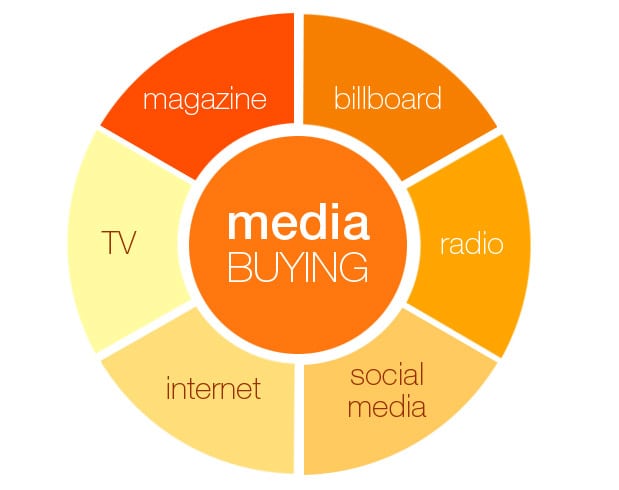
Image Credits: SOS Media Corp
How does one media buyer ensure efficiencies across so many different forms of media channels at their disposal?
Being jack of all trades is one way to go about it, but that doesn’t sound very efficient. What else?
Yep. You got it.
In an ideal scenario, there are specialized media buyers for each media channel.
- Broadcast media buyers (sometimes referred to as traditional media buyers)
- Print media buyers
- Digital media buyers
- Direct response media buyers
- Outdoor media buyers
But why can’t one guy handle everything?
The concern is not about one guy handling everything. In fact, in smaller set-ups, a one man media buying operation to handle all forms of media is the efficient solution.
But not when there is a question of bigger budgets (Millions. Maybe billions.) on each media vehicle in the media mix.
Bigger budgets is equals to more accountability and efficiency. It also means more negotiation power for even better rates and value additions.
![]()
5. How does media buying work?
Efficient media buying is a combination of three things:
- Negotiation skills
- Strong professional relationship with the media owners (or media representatives)
- Media clout
We’ve already discussed negotiation skills in detail. What we haven’t discussed however, are the grounds for negotiation.
Relationship and media clout are what equips a media buyer on the negotiation table.
A strong relationship with the media representatives can help media buyers to get better media deals, higher discounts, and more value additions. It can also sweeten the deal to secure key properties, software and sponsorship opportunities that have limited availability.
It may also be an important source for competitors’ media insights.
Coming to think of media clout, what does it sound like?
When media companies have many signed clients to act as their media custodians, they combine all their budgets together. That combined spending power of clients’ media spend is called media clout.
Media clout where the true power for negotiation lies.
Since the media buyer decides which media channel, gets or doesn’t gets a chunk from the overall media clout, or campaign budget, the media representatives become more open to discussions.
It is key weapon in a media buyer’s arsenal on the negotiation table.
A good media clout enables the media buyer and gives him or her more confidence to deliver better numbers.
![]()
6. The media buying process
The media buying process may vary at different media agencies, and as explained earlier, the role is not limited to negotiations only.
It is a vital piece of the advertising puzzle, and this diagram sums the overall role of media buying in the complete media planning and buying process:
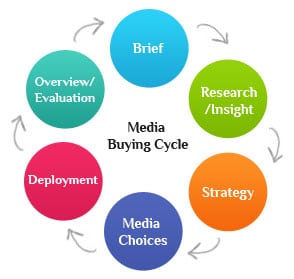
Image Credits: Xebec Digital
So how does a media buying process work?
A media buying strategy is derived from the overall advertising strategy of a client.
From a media buyer’s perspective, the overall process can be spread across 3 phases:
- Pre-Launch
- Launch
- Post-Launch
In the Pre-Launch phase, the media buyer analyzes and selects relevant media choices. Ensuring that the media selection leads to achieving the advertiser’s media and advertising objectives is his core focus.
Once he has a list of relevant media vehicles in place, he would look for programmes, shows and other opportunities that are likely to appeal his audience.
Audience affinity, viewership times, and credibility of the properties need to be assessed here.
As soon as he completes preparing his wishlist, he sets up meetings with several media representatives and starts negotiating: for optimal placements and best rates.
During the Launch phase, the buyer’s core responsibility is to ensure effective media delivery. He would have to keep monitoring whether the campaign is being executed as per the media plan and the deals agreed with the media owners.
This is usually done with the assistance of a in-house monitoring department, or a third-party tracking company.
In the Post-launch phase, the buyers needs to report back with the campaign’s efficiency in terms of campaign delivery, GRPs (gross rating points) achieved, value additions and overall savings as a result of negotiations
![]()
7. What are the benefits of media buying?
We’ve already discussed several advantages of having a media buying agency at your disposal. However, to sum it up, a media agency is going to add specialized value and strength in 3 key areas for you:
Savings – Get better deals because of the media clout and media relationships that media agencies maintain with media owners
Expertise – Media agency professionals have highly trained media buyers and media planners who’s core job is to deliver efficiency on their clients’ media budgets. And since they do the same thing over and over again for several clients, they have immense combined experience.
Efficiency – They have access to many tools and third party services, that enable them to deliver more efficiently.
![]()
8. What are the challenges of media buying?
It may seem at first that media buying is just about contacting advertising sales representatives, and media owners to get better deals. But there are several media buying challenges that exist.
Why? Because of an extremely competitive industry.
Firstly, a media buying agency needs to know of media opportunities before their competitors do. And considering there is cut-throat competition out there, it becomes a major challenge to leap on to key opportunities with a long process of client approvals involved at times.
Secondly, negotiations need to be smart. Which means that properties need to be bought at the right price, and not more, to maintain efficiencies across the entire media plan.
Thirdly, audience fragmentation on media, and the rise of new media, is making it more difficult to select media vehicles to ensure top performance.
![]()
9. Media buying negotiation strategies
Media buying negotiation can factor in several strategies. But, the strategy used needs to be based on certain objectives.
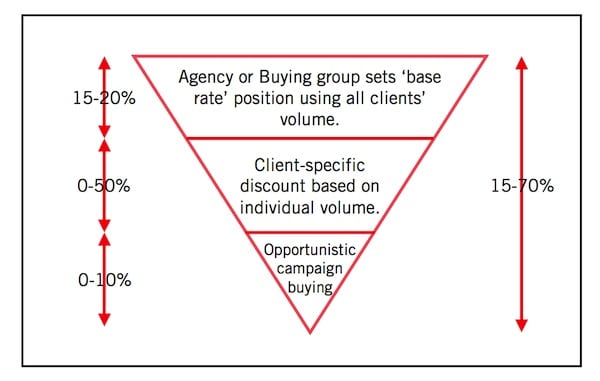
Figure Credits: TrinityP3
It is not possible to list out all media buying strategies for every medium. So, for the sake of generalizing, we will on a generic approach to media buying for broadcast channels (TV & radio).
The complexity involved in media buying, and specifically for television advertising, can be very challenging. When sitting on the same table as the media advertising sales rep to discuss rates, following are some common strategies that media buyers could use:
- Set a base rate – It is important to know what you’re going to spend on a particular media channel. Also, the minimum expectation in terms of discounts and value additions should be kept in place first.
- Media clout – Volumes speaks terms. In media negotiation, the more business volume a media agency has, the higher bargain power they can boast on the negotiation table.
- Media Commitment – Another way to sweeten the deal is to offer a future business commitment to the media representative. The business commitment can be in the form of media spends on that particular media channel.
- Value Additions – Another approach is to get more value in the same amount of money. More airtime, program sponsorships, content integration, etc.
- Sponsorships – Secure sponsorships on airtime commitment rather than paying a premium for a well rated program.
- Get ideas from the media owners – Listening to what they have to offer can help secure a great media deal
![]()
10. Media buying software
There are many media buying software and tools out there that help media agencies and media buyers, buy all media types including:
- Cable
- Broadcast
- Radio
- Newspaper
- Outdoor
- Digital / Web
There are many advantages to having a media buying software in place. It can help media buyers to organize their budgets, and streamline all processes for better delivery, tracking and reporting.
Following are some advantages of a media buying sofware:
- It saves time and improves efficiency
- Finding opportunities at your finger tips because a good media buying software can connect buyers with media properties
- It allows media releases to be sent to the media owners directly as a confirmation of rates, placements and deals
- Better financial management brings complete auditable integration to buy & sell media, and billing support
- Data & reporting is easier and a matter of a few clicks to arrive at reach and frequency numbers
- A good media buying software will offer multi-channel, multi-network and multi-media opportunities from a single window
However, such media buying software can be expensive to implement. If you’re looking for specific names of some well known media buying software, you can head over to Google and search for JDS, Strata, Donovan or Smart Plus.
Last modified: July 8, 2025

